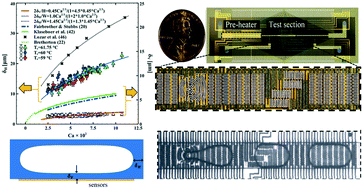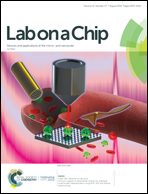Thermographic characterization of thin liquid film formation and evaporation in microchannels†
Abstract
The science of transport in microchannels has greatly benefited applications ranging from micro-mixing, chemical synthesis and biological analysis to compact and efficient energy devices. One of the most critical and intricate phenomena in this field of science is the dynamics of thin liquid film formation during the flow of liquid and gas/vapor mixtures. These films can form in microseconds and be less than a micrometer thick, while dominating thermal transport in phase-change processes. Here, we report the captured details of these phenomena using a new measurement technique with unprecedented spatial and temporal resolutions of 20 μm and 100 μs, respectively. Thin films with thicknesses ranging from 1 to 20 μm forming around elongated bubbles over a capillary number range of 0.025 to 0.1 are characterized. The measurements suggest that these films thermally develop and evaporate at timescales in the order of 1–10 ms, two orders of magnitude longer than their formation timescale. The formation, reflow and evaporation of the liquid film constitute a complex dynamic involving variations of the film thickness over the periphery of a rectangular channel, leading to a thicker liquid film feeding (through lateral capillary wicking) a much thinner rapidly evaporating film. As a result, the thinner film dictates the rate of surface heat transfer while the thicker film determines the duration of thin film evaporation. A modified Bretherton model provides the best fit to the experimental results.



 Please wait while we load your content...
Please wait while we load your content...
